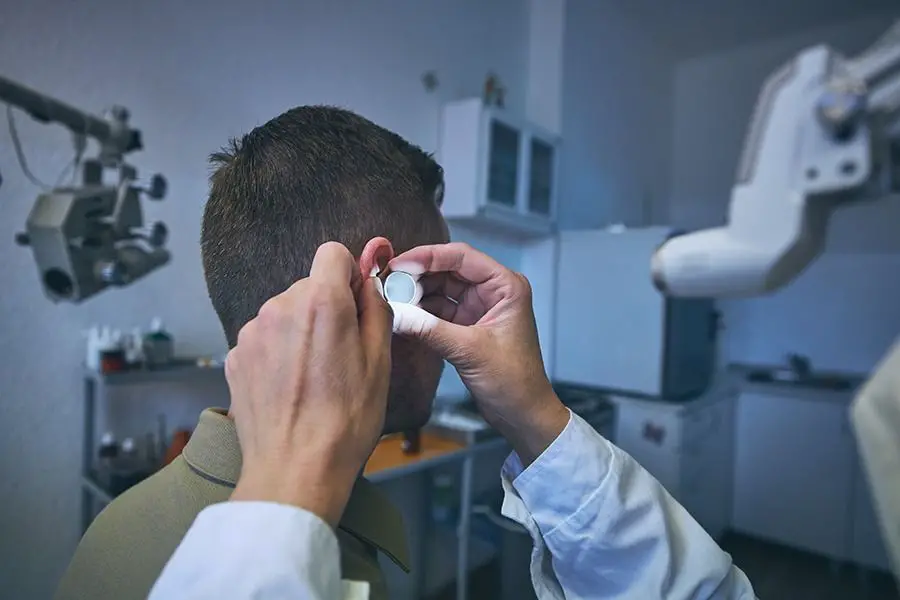Introduction
In a world where technology is continually evolving, so too are the tools and resources available for those dealing with conductive hearing loss. As a caretaker for someone with this condition, you play a pivotal role in exploring and leveraging these advancements to improve their quality of life. This blog post serves as a comprehensive guide, focusing on cutting-edge technologies and innovative approaches in managing conductive hearing loss.
In the quest to support those you care about, understanding the breadth of available options is essential. This not only encompasses traditional methods like hearing aids but also delves into assistive listening devices, smartphone apps, future tech, and even the application of 3D printing in the medical field. By sharing these developments, we hope to equip you with practical knowledge and inspire hope about the future of conductive hearing loss treatment.
It’s worth noting that hearing loss, particularly conductive, is not merely a health concern; it’s a daily life challenge. It’s about understanding the struggle to hear conversations in a noisy environment, the frustration of mishearing dialogues, and the solitude that comes from feeling disconnected. Therefore, our focus lies not just in discussing clinical advancements but also in promoting tools that make everyday life more navigable and enjoyable for those with conductive hearing loss.
In this article, we will also examine the potential of innovative surgical procedures that provide new possibilities for treating conductive hearing loss. Throughout our exploration, we encourage you to keep an open mind and consider how each of these options could fit into your loved one’s unique situation. Remember, each stride in technology isn’t just an advancement in medical science; it’s a potential leap toward improved quality of life for someone experiencing conductive hearing loss.
Sound Oasis® Bluetooth® Tinnitus Sound Therapy System®
Discover the ultimate solution for managing tinnitus with Play. This innovative device offers you 20 meticulously crafted built-in sounds, specifically recommended by esteemed audiologists worldwide. Dive into a world of soothing melodies and find respite from the challenges of tinnitus.
Immerse yourself in an audio oasis with Play’s integrated Bluetooth technology. Stream your favorite sounds or music wirelessly with a Bluetooth range of up to 30 feet (10 meters). Experience the freedom of wireless connectivity as you create your own personal sanctuary of sound.
Enhance your relaxation journey with the Sound Oasis Professional Tinnitus Frequency App, included with Play. Immerse yourself in a diverse range of calming sounds meticulously designed to alleviate tinnitus symptoms. Unwind, find serenity, and embark on a path towards improved sleep with this powerful companion.
Enjoy uninterrupted tranquility with Play’s versatile power options. Utilize the built-in rechargeable battery, providing you with 4-5 hours of continuous use per charge. Alternatively, keep Play plugged in using the included charging cable for extended periods of blissful sound. Dive into the soothing world of Play and experience the transformative benefits it brings to managing tinnitus.
Assistive Listening Devices for Conductive Hearing Loss
Assistive listening devices (ALDs) form a crucial pillar of support for individuals managing conductive hearing loss. These devices capture and amplify sound, delivering it directly into the ear. The primary function of an ALD is to enhance speech signals in noisy environments and to boost the volume of specific sounds such as a telephone ring or a doorbell.
Conventional ALDs include amplified telephones, television listening systems, and personal amplifiers. While these are beneficial, innovative technologies are revolutionizing the realm of ALDs. One such example is the adoption of wireless technology. Wireless ALDs, like FM systems, use radio signals to transmit amplified sounds directly to the user. They’re especially useful in places like classrooms or public speaking events, where the speaker’s voice needs to be distinguished from background noise.
Another groundbreaking ALD is induction loop systems, which employ electromagnetic energy to deliver sound. They work seamlessly with telecoil-equipped hearing aids and cochlear implants, making them an excellent option for people who already use these devices. As technology progresses, we anticipate even more advanced ALDs, offering better sound quality, connectivity, and ease of use, ultimately fostering an enhanced listening experience for individuals with conductive hearing loss.
https://www.hearing-loss.news/authoritative-sources/
Smartphone Apps for Managing Conductive Hearing Loss
In today’s digital age, our smartphones serve many purposes beyond mere communication. For those with conductive hearing loss, smartphones can become an important tool for managing and mitigating hearing challenges. A variety of apps have been designed to work in conjunction with hearing aids and assistive listening devices, transforming your smartphone into a powerful, personalized hearing assistant.
There are apps available that allow for hearing aid adjustments right from your phone. You can adjust the volume, change the settings for different environments (like a quiet room or a noisy restaurant), and even direct the audio from your phone calls or music straight to your hearing aids. This provides an unprecedented level of control and customization for users, leading to an improved hearing experience.
Other apps focus on providing visual or vibratory notifications for sounds in the environment. This can be helpful for people with severe hearing loss who may not hear doorbells, alarms, or other important sounds. Then there are transcription apps, which use speech-to-text technology to transcribe conversations in real-time, aiding those who may struggle to understand speech, even with the help of hearing aids.
The world of smartphone apps for hearing loss is vast and varied, and new applications are continually being developed. As a caregiver, familiarizing yourself with these resources can be invaluable in aiding those you care for. By harnessing the power of smartphone technology, you can help turn a device that is often in your loved one’s pocket into a powerful tool for managing their conductive hearing loss.
What to Look for in Inexpensive Hearing Aids
The Future of Conductive Hearing Loss Treatment: A Look at Upcoming Tech
Looking into the future, promising technological advancements could redefine the treatment landscape for conductive hearing loss. For instance, there are ongoing developments in the field of regenerative medicine with scientists actively researching the use of stem cells to repair the damaged structures in the ear that cause conductive hearing loss. While still in experimental stages, this could pave the way for new treatments that go beyond just managing the symptoms, potentially restoring natural hearing capabilities.
Another area of significant potential is the development of ‘smart’ hearing aids, which would use artificial intelligence (AI) to optimize their function. These smart aids could learn from the user’s habits and environment to automatically adjust their settings for optimal hearing in any given situation. This could provide a significant improvement in user experience, reducing the need for manual adjustments and ensuring the best possible sound quality at all times.
Additionally, researchers are exploring the potential of ‘bionic’ ears that use a combination of electronics and living tissues. While the concept may sound like science fiction, preliminary studies have shown promising results, opening up exciting prospects for the future of conductive hearing loss treatment.
Tinnitus: why it’s still such a mystery to science
The Role of 3D Printing in Treating Conductive Hearing Loss
In recent years, 3D printing technology has been making waves in the medical field, and its applications for treating conductive hearing loss are no exception. One of the key areas of application is the creation of custom-designed ear implants. These 3D-printed implants can be tailored to the individual’s unique anatomy, potentially leading to better fit, enhanced comfort, and improved hearing outcomes.
Furthermore, 3D printing allows for the creation of complex structures that were previously challenging, if not impossible, to create using traditional manufacturing methods. For instance, researchers have successfully 3D-printed a replica of the middle ear’s tiny, intricate bones. This could revolutionize the way surgeries are performed, with surgeons potentially able to replace damaged ear bones with 3D-printed replicas.
While still in its infancy, the application of 3D printing in treating conductive hearing loss is an exciting development. As this technology continues to mature, it could offer new treatment options and improved outcomes for those with conductive hearing loss.
QUIZ - TINNITUS AND ITS SYNONYMS
Innovative Surgical Approaches to Conductive Hearing Loss
Surgery has long been a treatment option for certain types of conductive hearing loss. However, innovative approaches and advancements in medical technology have broadened the scope of what’s possible. Minimally invasive surgeries, for instance, reduce the risk of complications and speed up recovery time.
One of these advancements is endoscopic ear surgery, a technique that uses a small camera to provide a detailed view of the middle ear’s structures. This allows surgeons to perform procedures with more precision and less collateral damage, leading to improved outcomes.
Laser technology is another innovation transforming ear surgery. Lasers can be used to precisely cut or remove tissue, reducing the risk of damage to surrounding structures. They’re particularly useful in procedures like stapedotomy, which involves replacing one of the tiny bones in the middle ear.
With ongoing advancements in technology and surgical techniques, the future looks bright for those seeking surgical treatment for conductive hearing loss. It’s an ever-evolving field, and who knows what incredible innovations the coming years will bring?
Conclusion
Through the course of this comprehensive exploration into the world of conductive hearing loss, it’s clear that technological advancements are propelling us toward a future where this type of hearing impairment can be more efficiently managed and perhaps even entirely corrected. From assistive listening devices designed to amplify and clarify sounds, to smartphone apps that allow users to fine-tune their listening experiences, the horizons are expanding for those living with conductive hearing loss.
The prospect of emerging technologies, such as regenerative medicine and smart hearing aids, point toward a future where the boundaries of what’s possible are continually pushed. These developments may one day allow for not just the management of conductive hearing loss symptoms, but the restoration of natural hearing capabilities – a game-changer in the field.
3D printing’s increasing application in the creation of custom-designed ear implants and intricate middle ear structures marks an exciting chapter in the treatment narrative. This innovation allows for greater precision in surgical interventions and is set to revolutionize the field of otology.
Surgery, while a long-standing treatment for conductive hearing loss, is also seeing innovative techniques being applied. The use of endoscopic approaches and laser technology is improving precision, reducing risk, and enhancing patient outcomes. This, coupled with advancements in 3D printing and regenerative medicine, is reshaping the treatment landscape, offering new hope to those affected.
As we move forward, it’s crucial to remember the importance of regular hearing checks, early intervention, and staying informed about the latest developments in treatment options. With technology progressing at a rapid pace, the future of managing and treating conductive hearing loss holds promise, leading us towards a world where the impact of hearing loss can be significantly reduced.

Harmonizing Life with Mixed Hearing Loss: Insights and Innovations from Asia
Dive into the world of Mixed Hearing Loss with a focus on Asia, highlighting cultural impacts, treatment innovations, and practical management tips.

Navigating the Crossroads of Conductive Hearing Loss and the COVID-19 Pandemic
This blog post offers supportive insights into the intersections of conductive hearing loss and the COVID-19 pandemic – emerging connections, treatment accessibility, coping strategies, changes in research, and the growth of virtual support communities.
REFERENCES
Hearing Link
A UK-based hearing loss organization offering information and support to individuals and families, including resources on conductive hearing loss.









